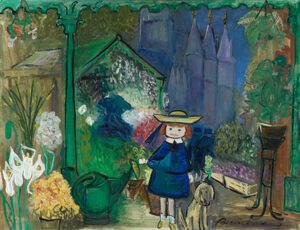Frances Oliver

The Covid lockdown has sent me back to old favourite books, and I have just revisited two by Ludwig Bemelmans, one from my parents’ art book collection, My Life in Art, and a battered autobiography, Life Class, from mine.
Ludwig Bemelmans (1898–1962), born Austro-Hungarian, later American, was a writer and painter renowned chiefly for his children’s books. The most successful is the classic Madeline series, about a little girl at a convent school in Paris, with big colourful illustrations of famous Paris scenes. Bemelmans himself had a grim and dramatic childhood, his father abandoning the boy’s mother and his governess after impregnating both. The governess – deeply loved by the boy, as he writes in My Life in Art – committed suicide; the mother had to raise the boy alone. Ludwig was quick-tempered and troublesome. Rather than continuing school he was sent in his early teens to work for a hotelier uncle. Tormented by a cruel waiter, his boss at the hotel, Ludwig threatened to shoot him, and finally did shoot him in the leg. Uncle Hans gave Ludwig a choice between reform school and emigration to America. Ludwig chose America, where his father was. Typically, his father did not meet him at the dock as planned. Sixteen-year-old Ludwig spent a lone Christmas on Ellis Island, but then managed to find hotel jobs, landing at the Ritz-Carlton, where he worked for 15 years until his success with children’s books enabled him to live by his writing and his art. He also wrote fiction, essays on food and drink, and autobiography.
As a child I loved Madeline and the other books. Our Dachshund had to be Pretzel, named after one in Bemelmans’ book, and when our parents first took my sister and me to (in our case, back to) Europe, what I most wanted was to go to Bruges and stay in the real hotel from The Golden Basket, another favourite Bemelmans. So I was delighted when my husband and I, many years later, found that second-hand paperback, which remains one of the funniest books I have ever read. Life Class is mainly about Bemelmans’ experiences as a waiter at the Ritz. The staff, and the guests – of whom many were wealthy regulars – are totally and embarrassingly alive. No quirk of character, no unfortunate physical detail, escaped young Ludwig’s pencil or pen – for there are of course little drawings as well.
Bemelmans’ volatile temper remained. A fight with another worker who called him Sale Boche (dirty German) ended with Bemelmans responding with a missile of ice chips, lobbing a silver tray which cut his opponent’s face and put him in hospital. However, at the end of it all Bemelmans paid the medical bills and the two shook hands. I myself have a testimonial to that explosiveness; an old Austrian who knew Bemelmans told us of a memorable dinner party at which Bemelmans threw a cooked trout at his then girlfriend. So it is not surprising that sometimes his humour is cruel, but it never spares himself, and some of the eccentric staff are described with affection and respect. Most notable is Bemelmans’ friend Mr Sigsag, who has made his way up to a chef de rang from a piccolo in Europe years before. A piccolo was a little boy apprentice in a restaurant who worked from 6 am to 11 pm seven days a week and had to spend his nights sleeping on the restaurant chairs. This book is a mine of fascinating and disturbing information about the workings of international hotels between the wars.
My Life in Art is a book of paintings and drawings with three chapters of text. The first, nostalgic and moving, is about Bemelmans’ early childhood in the Austrian resort of Gmunden; the second about his bureaucracy-thwarted attempt to convert an old Paris building into a bistro and studio; the last about how Salinas, a fellow artist, taught him to paint in oils. The oils and gouache pictures were done between 1954 and 1958. The compositions are sometimes awkward, at least in reproduction; the colours are wonderful. These oils have the children’s book immediacy and freshness of the Madeline illustrations. There are buildings, landscapes, people, including a few of women in cafés whose steadily drawn but distinctive features recall Steinberg or Toulouse-Lautrec. One painting of a naked, dead-white nightclub dancer trailing a purple scarf in one hand has a strange coloured background of watching faces. Another titled Clochards (tramps) shows a sad old man and a fascinated little girl gazing through a window at bottles of wine and a bowl of fruit; these were people Bemelmans knew and he painted them with haunting beauty and wistfulness.
Bemelmans spoke of impatience as a major trait of his and perhaps it is just that impatience that gives his paintings their vitality. They present a vivid, restless, fleeting world; they are like sketches, brilliantly simple sketches, in oil. I will end this review with the three perfectly apposite sentences Bemelmans used to end My Life in Art: “If a painting goes well, then it goes that way like a happy little train running through a landscape, whistling. And the picture is there forever: it looks back at you and thanks you. It has its own clear voice and says it day and night and forever.”
Volume 35 no 2 November / December 2020
